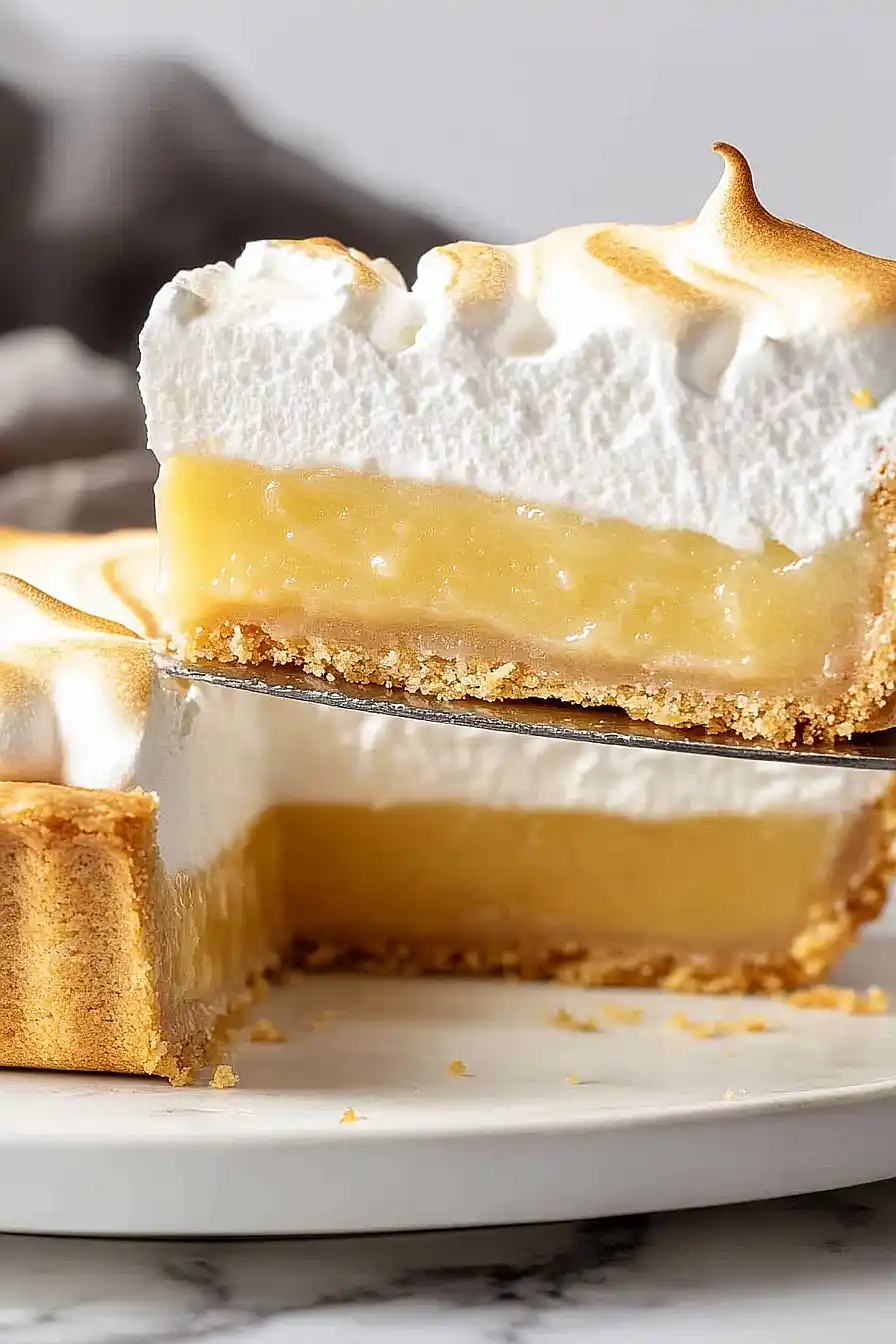I didn’t try making a lemon meringue pie until I was in my thirties because I thought it would be too hard. Mom always bought hers from the local bakery, saying it was “too fussy” to make at home. The first time I attempted one, I used a pre-made graham cracker crust, and it was… well, let’s just say the dogs wouldn’t even eat it.
That’s because I was going about it all wrong—trying to rush the process and skipping important steps. This biscuit base version, though? It’s become my go-to recipe. The cookie crust is much more forgiving than pastry, and it gives the pie a nice crunch that works really well with the smooth lemon filling.
Why You’ll Love This Lemon Meringue Pie
- No-bake crust – The biscuit base means no fussy pastry making – just crush, mix with butter, and press into the pan. It’s so much easier than traditional pie crust!
- Perfect balance of flavors – The combination of tangy lemon filling, sweet fluffy meringue, and buttery biscuit base creates a dessert that hits all the right notes.
- Make-ahead friendly – You can prepare the crust and filling ahead of time, then top with fresh meringue just before serving – perfect for busy days or special occasions.
- Classic dessert made simple – This recipe breaks down a classic dessert into manageable steps using common ingredients you can find at any grocery store.
What Kind of Biscuits Should I Use?
For a lemon meringue pie base, you’ll want to use plain, sweet biscuits that can be easily crushed into fine crumbs. Marie biscuits are a classic choice because they have a light, sweet flavor that won’t overpower the lemon filling, but you can also use graham crackers, digestive biscuits, or vanilla wafers. The key is picking a biscuit that’s crisp and not too thick – avoid anything with cream fillings or chocolate coatings. Just make sure your biscuits are fresh and dry (stale biscuits can make your base taste off), and crush them into very fine crumbs for the best texture in your pie base.
Options for Substitutions
Need to make some swaps? Here’s what you can do with this lemon meringue pie recipe:
- Marie biscuits: Any plain sweet cookie works great here – try graham crackers, digestive biscuits, or even vanilla wafers. Just make sure they’re not too strongly flavored.
- Lemon juice and zest: While fresh lemon juice gives the best flavor, you can use bottled lemon juice in a pinch. For a fun twist, try lime juice and zest, or mix lemon and lime together. Just don’t skip the citrus – it’s what makes this pie special!
- Cornstarch: You can swap cornstarch with arrowroot powder (use the same amount) or potato starch. For the filling, you’ll need to cook it a bit longer with arrowroot to get the right thickness.
- Superfine sugar: Regular granulated sugar works too – just pulse it in a food processor for a few seconds to make it finer. Don’t use powdered sugar as it contains cornstarch and will change the texture.
- Unsalted butter: If you only have salted butter, that’s fine – just skip the pinch of salt in the recipe. For dairy-free options, coconut oil works in the crust, but the filling really needs real butter for the right texture.
Watch Out for These Mistakes While Baking
The biggest challenge when making lemon meringue pie comes from the meringue weeping or becoming grainy – to prevent this, make sure your egg whites are at room temperature and add the sugar gradually while beating, not all at once. A common error is overworking the biscuit base, which can make it too compact and hard to cut – instead, press the mixture gently into the pan with the back of a spoon until just combined. The lemon filling can become lumpy if you don’t whisk constantly while cooking, so keep stirring over medium heat until it thickens smoothly, and strain through a fine-mesh sieve if needed. For the best results, let the lemon filling cool completely before adding the meringue, and make sure to spread the meringue right to the edges of the crust to prevent shrinkage during baking.
What to Serve With Lemon Meringue Pie?
This zesty dessert is perfect on its own, but there are some nice ways to make it even more special! A dollop of fresh whipped cream on the side adds a lovely richness that balances out the tangy lemon filling. For a refreshing summer combo, serve your pie with a scoop of vanilla ice cream or a handful of fresh berries like raspberries or strawberries. If you’re serving this at a dinner party, a cup of hot coffee or Earl Grey tea makes for a perfect pairing – the warm drinks complement the cool, creamy texture of the pie really nicely.
Storage Instructions
Keep Fresh: Your lemon meringue pie will stay best in the refrigerator, covered loosely with foil (avoid plastic wrap as it can stick to the meringue). It’s good for up to 3 days, though the meringue is at its peak on the first day. The base might soften slightly over time, but it’ll still taste great!
Make Ahead: Want to prep in advance? You can make the biscuit base and lemon filling a day ahead, keeping them in the fridge. Just add the fresh meringue topping on the day you plan to serve. This way, you’ll get that perfect, fluffy meringue texture that everyone loves.
Serve: Take the pie out of the fridge about 15-20 minutes before serving to let the flavors develop. Keep in mind that lemon meringue pie doesn’t freeze well – the meringue can become watery and the texture changes quite a bit, so it’s best enjoyed fresh!
| Preparation Time | 30-45 minutes |
| Cooking Time | 25-30 minutes |
| Total Time | 55-75 minutes |
| Level of Difficulty | Medium |
Estimated Nutrition
Estimated nutrition for the whole recipe (without optional ingredients):
- Calories: 3500-4000
- Protein: 50-60 g
- Fat: 200-220 g
- Carbohydrates: 400-450 g
Ingredients
- 250 g plain sweet biscuits, such as arnotts marie (approx. 8.8 oz)
- 100 g melted unsalted butter (3.5 oz or 7 tablespoons)
- 1 egg white
- 150 g superfine (caster) sugar (approx. 3/4 cup or 5.3 oz)
- 1/3 cup cornstarch (cornflour) (around 40 g or 1.3 oz)
- A pinch of salt
- 180 ml fresh lemon juice (about 3/4 cup)
- 250 ml water (1 cup)
- 42 g chopped unsalted butter (1.5 oz or 3 tablespoons)
- Zest from 2 lemons, finely grated (approx. 1 tablespoon)
- 5 egg yolks
- 4 egg whites, cold
- 3 teaspoons cornstarch (cornflour)
- 200 g superfine (caster) sugar (approx. 1 cup or 7 oz)
Step 1: Prepare the Crust
Preheat your oven to 180°C / 350°F / 160°C fan-forced.
Begin by separating your eggs; set aside one egg white while keeping the remaining egg whites together in the fridge.
The yolks can remain at room temperature.
Process the biscuits into crumbs using a food processor.
Whisk the single egg white until it becomes slightly frothy, then add it along with the melted butter to the biscuit crumbs.
Mix or process until the mixture is well combined and resembles wet sand.
Transfer the crumbs to a 9-inch removable base tart tin and level them out.
Use a flat-bottomed glass to press them firmly into the base and up the sides of the tin.
It may seem crumbly at first, but it will come together.
Place the tart tin on a baking tray and bake for 10 minutes.
Then, set it aside to cool.
Step 2: Make the Lemon Filling
In a saucepan, combine sugar, cornflour, and salt, and then pour in the lemon juice and water.
Whisk vigorously until well combined.
Cook over medium heat, whisking regularly to avoid lumps, until you have a thick gel with large bubbles popping on the surface.
Remove from the heat and add the butter and lemon zest, mixing until melted and fully incorporated.
While whisking vigorously, add the egg yolks to prevent scrambling.
Place the saucepan back over medium heat and cook for an additional minute until the mixture reaches 71°C / 160°F on a digital thermometer.
Pour the lemon filling into the tart base and allow it to cool at room temperature for about 30 minutes.
The filling should still be warm when you proceed with the meringue.
Step 3: Prepare the Meringue
Using a stand mixer with a whisk attachment, whisk the reserved egg whites on medium-high speed until soft peaks form.
Sift the cornflour over the egg whites and mix on low speed to combine.
Increase the mixer speed to medium and add the sugar one tablespoon at a time, waiting about 20 seconds between each addition.
Once all the sugar has been incorporated, scrape down the sides of the bowl to mix in any remaining sugar crystals.
Beat on high speed until the meringue is glossy with stiff peaks, checking that no sugar grains remain by rubbing a little between your fingers.
Scoop the meringue onto the lemon filling, gently pressing it out towards the edges while keeping a slight hill in the middle.
Ensure the meringue touches the crust all around.
Create peaks or a swirly pattern on the meringue with your spatula.
Step 4: Bake and Cool the Tart
Bake the tart with the meringue for 15-20 minutes until the top is golden.
For an extra toasted look, you can use a kitchen blow torch on the cooled meringue.
Allow the tart to cool at room temperature for 2 hours, then place it uncovered in the fridge to cool completely (3-4 hours) before slicing.
Maintaining contact between the meringue and crust will allow the tart to stay fresh if refrigerated overnight.


